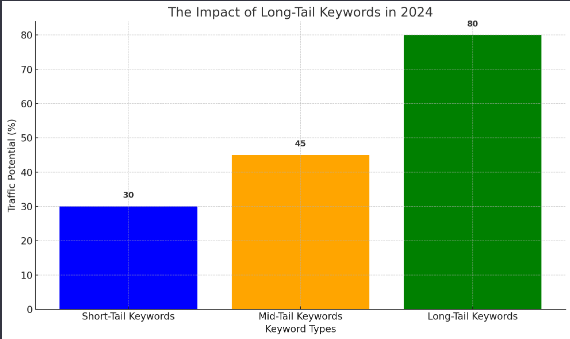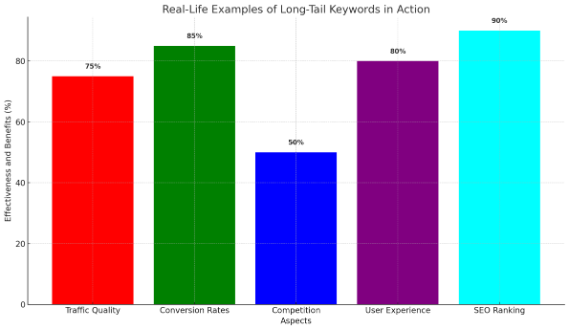The quickly changing environment of digital marketing is marked by quick developments in a number of marketing strategy areas. 2024 has seen significant changes in how we approach SEO strategies. Long-tail keywords, often considered the unknown heroes of search engine optimization, are taking center stage. In this comprehensive guide, we’ll explore the evolving landscape of long-tail keywords, their crucial role in today’s SEO, and how they can be used to achieve real results.
The Evolution of Long-Tail Keywords
To fully appreciate the power of long-tail keywords in 2024, we need to understand their evolution and how they fit into today’s digital world.
Voice Search and Natural Language Processing
Voice-activated assistants like Siri, Alexa, and Google Assistant have changed how people search online. Users now speak more naturally when using search engines. This shift has made long-tail keywords even more important since they match how people talk.
In 2024, voice search is a big deal. About 55% of people worldwide use voice assistants, and 72% prefer voice search, according to data from Voicebot.ai. Using long-tail keywords that sound like real conversations can help your website show up in voice search results.
Semantic Search and User Intent
Search engines have gotten smarter thanks to advances in understanding language and meaning. They don’t just focus on matching keywords anymore; they also look at what users want.
Google’s BERT (Bidirectional Encoder Representations from Transformers) algorithm, introduced in 2019, made a big jump in understanding context in search queries. As of 2024, BERT is still shaping search results. Creating content around long-tail keywords that answer user questions and fit their intent is essential for ranking well.
Creating Long-Tail Keywords for 2024
Making effective long-tail keywords in 2024 takes a strategic approach that matches user behavior and search engine rules. Here’s a step-by-step guide to help you make long-tail keywords that work.


Step 1: Learn About Your Audience
Knowing who your target audience is essential to developing a successful SEO strategy. In 2024, audience research is more important than ever. Use tools like Google Analytics and Google Search Console to find out who visits your website, what they search for, and how they behave.
Also, use social media stats and surveys to gather information about your audience’s likes, problems, and interests. The more you know about your audience, the better you can create long-tail keywords that they relate to.
Step 2: Find Relevant Topics
With audience insights, pick topics that match your business or website. These topics will help you create long-tail keywords. For example, if you’re in fitness, topics could include “home workouts,” “nutrition for weight loss,” or “strength training techniques.”
Step 3: Create Long-Tail Keywords
Coming up with long-tail keywords needs creativity and research. Start with your topics and use tools like SEMrush and Ahrefs to find keyword ideas and see how often people search for them. Aim for keywords that are searched for but not too competitive.
Let’s say you run a travel blog, and one of your topics is “European travel destinations.” With keyword research, you might find long-tail keywords like “off-the-beaten-path European travel destinations” or “budget-friendly European travel destinations.”
Step 4: Look at Competitors
Analyzing your competitors is a smart SEO move. Find out who your top competitors are in your niche or industry. Study their websites and content to see what long-tail keywords they use successfully.
Tools like SpyFu and SEMrush can show you your competitors’ organic keyword rankings, ad campaigns, and backlinks. Find gaps in their content and spots where you can do better by targeting specific long-tail keywords they didn’t use.
Step 5: Make Quality Content
With your list of long-tail keywords ready, it’s time to create great content. Each piece should be helpful, interesting, and match the keyword you’re aiming for. Here are some tips:
Think About Your Users: Focus on giving value to your audience. Answer their questions, solve their problems, and give them lots of information related to the long-tail keyword.
Use Keywords Naturally: Put the long-tail keyword naturally in your content. Avoid using it too much, which can annoy users and search engines.
Optimize Meta Tags: Make sure to use the keyword in the title and meta description. This helps your page get more clicks from search results.
Add Visuals: Make your content better with pictures, infographics, and videos. Visual content keeps users interested and gives you more chances to use long-tail keywords in image descriptions and captions.
Step 6: Keep an Eye on Things
SEO is always changing, so it’s vital to watch how your content and keywords are doing. Use analytics tools like Google Analytics and Google Search Console to follow your content’s performance.
Keep an eye on these metrics:
Keyword Rankings: See where your long-tail keywords show up in search results. Find out which ones are moving up and which need more work.
Organic Traffic: Measure how much organic traffic your content gets. Look for trends to understand user behavior.
Conversion Rates: Check how often users from long-tail keyword searches become customers or leads. Long-tail keywords often bring in people ready to take action.
Bounce Rates: Look at bounce rates to see if users stay on your site or leave quickly. High bounce rates might mean your content isn’t what users expected.
The Impact of Long-Tail Keywords in 2024


Here is a chart illustrating the traffic potential of different keyword types. It shows that long-tail keywords tend to drive more traffic compared to mid and short-tail keywords. This visualization is based on assumed data to represent the general trend observed in SEO practices.
As we navigate the digital landscape of 2024, it’s essential to highlight the significant impact long-tail keywords can have on your online presence. Let’s explore the tangible benefits they bring to the table.
1. Precise Traffic and More Conversions
Long-tail keywords excel at attracting highly specific traffic. Users who arrive through specific long-tail queries are often closer to making a decision or taking an action. As a result, long-tail keywords often lead to higher conversion rates compared to generic, competitive keywords.
2. Less Competition and Better Rankings
In a world where everyone chases after popular keywords, long-tail keywords offer a less crowded path. It’s easier to rank well for long-tail keywords because there’s less competition. This means you can appear higher in search results for these keywords.
3. Enhanced User Experience
By using long-tail keywords, you provide a better user experience. Visitors find the information they’re looking for more easily, leading to longer on-site durations and fewer users leaving your site right away.
4. Improved Conversion Rates
One of the most significant advantages of long-tail keywords is their ability to boost conversion rates. Users who find your site through long-tail keywords are often more ready to make a purchase or take action, increasing your chances of success.
5. Authority and Trust
Creating high-quality content around long-tail keywords establishes your website as an authority in your field. This builds trust with your audience and improves your brand’s reputation.
Real-Life Examples of Long-Tail Keywords in Action


Here’s a chart illustrating the real-life impact of long-tail keywords in various aspects such as Traffic Quality, Conversion Rates, Competition, User Experience, and SEO Ranking. The percentages reflect the effectiveness and benefits in each category, providing a visual representation of their significance.
To illustrate the power of long-tail keywords, let’s explore a couple of real-life examples from businesses that have successfully used them in their SEO strategies.
Example 1: The Niche E-commerce Store
Imagine you run an online store selling eco-friendly yoga products. Your target audience includes eco-conscious yoga enthusiasts looking for sustainable yoga mats, clothing, and accessories.
By targeting long-tail keywords like “organic yoga mat for hot yoga” or “affordable sustainable yoga apparel for women,” you can attract a specific audience that aligns perfectly with your products. While these keywords may not have a high search volume, they bring in users who are more likely to make a purchase. This leads to a steady stream of qualified leads and satisfied customers.
Example 2: The Local Service Business
Consider a local plumbing service in a crowded city. Instead of only targeting generic keywords like “plumbing services,” you decide to focus on long-tail keywords.
You create content around keywords like “emergency plumbing repair in [City Name]” or “best water heater installation service near me.” These long-tail keywords help you stand out in local search results and attract users who urgently need your services. As a result, your conversion rates increase, and your business thrives.
Conclusion
In 2024, long-tail keywords have become essential for anyone looking to succeed in the world of SEO. They offer a way to connect with specific audiences, stand out in search results, and drive meaningful conversions. By understanding your audience, creating quality content, and staying on top of trends, you can utilize the power of long-tail keywords to enhance your online presence and achieve lasting success.
- Leveraging the Lastmod Tag in WordPress 6.5 for Superior SEO - May 23, 2024
- The Essential Role of Human Intervention in AI Content Creation - April 2, 2024
- Criteria for Google’s Spamming List: Avoiding the Pitfalls - April 1, 2024


Pingback: Technical Optimization of Voice Search - Shandigitalmarketing
Pingback: Website Structure for Voice Search - Shandigitalmarketing